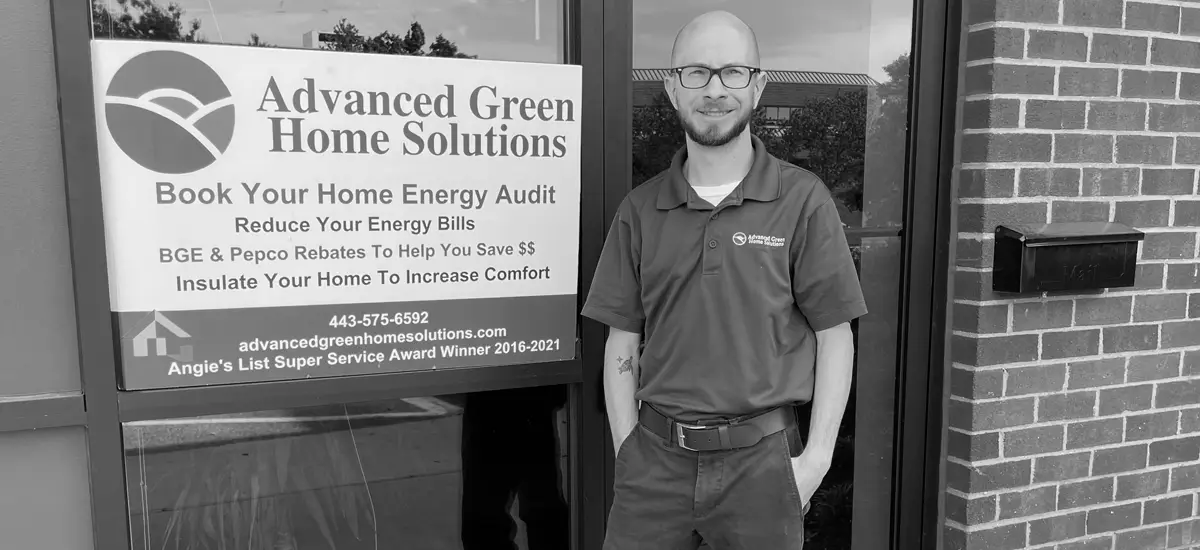
Who Did It Best? Tales of a Home Energy Expert
They’ve visited hundreds of local homes. They’ve diagnosed countless energy inefficiencies. They’ve recommended an equal number of solutions. They’re BGE Participating Contractors who love their jobs and would do anything for the people they serve. One’s a community guy who sees this as his calling to better serve his community. The other? A pure problem solver who loves to seek continual improvement.
GettyImages
You get to meet them both right here.
Say hello to Tyrell Armstrong
When you’re in the room with Tyrell, you immediately feel his natural, almost effortless sense of calm. He has the focus and quiet confidence of a man who knows his purpose. And that’s because he does. Tyrell found both his place in this world and his calling, that rare intersection of making a living and doing something you find truly rewarding. And what does Tyrell do for a living? As a Quick Home Energy Check-up professional, he helps people save money.
When you book an appointment, a specialist like Tyrell performs a roughly one-hour walk-through of your home pointing out ways you can be more energy efficient. Insulation levels and air leakage are inspected. Upgrades like LED light bulbs and smart power strips are installed with your permission. Best of all—and this is Tyrell’s favorite part—as a BGE customer, you enjoy this service at no additional cost.
We sat down with Tyrell and found out what makes him tick—and what you can learn from his experience evaluating hundreds of homes across central Maryland. We’re guessing what you’ll learn will go well beyond energy efficiency.
How did you start helping people with their energy efficiency?
I used to work at a nonprofit called Civic Works, supporting a program called “Project Light Bulb.” We would go door to door, informing people of energy-saving tips and products and letting them know about different BGE programs.
How’d that make you feel?
It was actually pretty cool because a lot of people in the inner city have no idea that BGE even had these types of programs. All they knew about BGE was their bill.
And if you’ve volunteered before you “went pro,” you must feel pretty passionate about helping people.
Yes, I really do. I went to Civic Works for some training and I kind of found my passion. Everyone has that niche in life, and you don’t know it until you come across it. This was mine. The guy who trained me said we both grew up in the same neighborhoods. When he trained me up, he opened a new door and avenue in my life. And I’ve been working on it ever since.
That’s so cool that you grew up in the same area—such a small world.
Yeah, it’s funny that way. Baltimore is just one of those cities where we have a bunch of mutual friends but never actually met one another until the program.
Your job allows you to be involved in this community.
I grew up in East Baltimore. Born and raised here. Helping is in my DNA. I can’t explain the joy I get out of it. Everybody has their passion. I always had a passion for building, but once I got into the whole house-building science, that’s when it really got interesting.

Do you feel that sense of community when you visit these homes?
Yes. Some houses I do. Some I don’t, you know? When you come into a customer’s home, they automatically think you’re trying to sell them something. So, you have to let them get to know you and what you’re bringing them—that you’re actually there to help. Once you get past that barrier, that’s when people seem to open up.
Take us through a typical visit.
Once I get to a home, I explain why I’m there. I’ll ask the customer what made them sign up for an appointment. Most of the time, they received a high bill for that month and want to know why. They automatically want to blame the meters. We walk through with the customers to check on the efficiency of their equipment, their habits and their actual usage. Once we walk through all of those, a lot of times, we have come up with solutions that had nothing to do with the meter.
There has to be a story there.
Yeah, a prime example: I had a couple who had a one-floor condominium, and they had a $900 energy bill for the month. They just couldn’t believe that. They said it was something going on with the meter. I was asking about their habits. Come to find out, the gentleman doesn’t like the heat. Well, his wife likes the heat. So, his wife had the electric baseboard heat running, and he had the A/C running. They were running both at the same time.
Wow, that’s taking the thermostat wars to an extreme.
Exactly. Yeah, they were battling each other. Then, of course, she kind of lit into him while I was there. So yeah, I gave them a solution and got out of there. I’m sure he was probably in trouble once I left.
Do you see that a lot?
Yeah, a lot of times the high energy costs can be related to appliances, bad habits with lighting or the kids snuck in a space heater that the parents didn’t have any idea about—things like that.
And then some homes are just not energy efficient. For example, a couple installed a high-end heating and cooling system in an inefficient home, without insulation.
So that’s when we can check the draft in the home, recommend installing insulation and tell them about the utility rebates that go along with it. That will help them in the long run.
So, you see people spending money solving the wrong problem?
We had a customer once who spent almost $14,000 to get insulation blown into his home. No air sealing was done, and no ventilation measures were taken care of, so he wasn’t getting the expected results. He wasn’t too happy of a camper. He wanted me to perform a comprehensive home energy audit, which showed what he needed to do.
It’s hard to tell people that kind of hard truth. Because you feel sorry for them. But you come up with a solution, and you let them know. And leave the cards in their hands.
How do you handle breaking that kind of news?
I don’t like it, but I like for people to know the truth. Truth always prevails, so you just give them the hard truth. Sometimes, you have companies that do a horrible job. This example had roof leaks on top of it. There was no air sealing. Then I explained to him that the insulation wasn’t doing anything but just being an air filter right now for his conditioned air leaving the house.
Very often, you see them do one thing. Too often, that’s not enough.
Yeah, it is a whole-house approach, most definitely. You need to know the total building science when you go into making improvements, so you can make their home safe and efficient.
Would you do anything else when it comes to a career?
No, I found my spot. I found my niche, and this is it. You can tell. Can’t you see the joy on my face?
Schedule your own Quick Home Energy Check-up at BGESmartEnergy.com/Quick3.
Digital Bonus: Say hello to Shane Miles
One look at Shane, and you can tell he’s searching for the next problem to solve, that the wheels are always turning. He just loves to fix things, to make things better. And, to be the best he could be, Shane knew he had to learn as much as he could.
That’s why conducting home energy audits for BGE’s Home Performance with ENERGY STAR® is the perfect job for him. As a Participating Contractor, he performs in-depth, comprehensive home energy efficiency evaluations. It’s a service available to BGE residential customers at a deep discount thanks to EmPOWER Maryland: just $100 (a $400 value).
When Shane visits your home, he gets to work using high-tech tools like a thermographic camera and blower door test to look at every nook and cranny for energy-savings opportunities.
He checks. He inspects. He measures. And, after the audit, Shane gives his full report and makes recommendations for efficiency improvements. He’ll even point out the many rebates and incentives available through BGE and EmPOWER Maryland to help make the upgrades more affordable.
We sat down with Shane to find out what makes him tick and if he had any good home inspection stories. He did.
Where did your energy efficiency story begin?
Honestly, right out of high school. It started off as just me working in construction. I did that for over 11 years. I was a crew leader. Then I moved to Home Performance. I never meant this to be a career, but here I am still doing it.
Sometimes people find their careers. Sometimes their careers find them.
I started with air sealing in attics. I decided to do electrical work. I went to school for that, to get my journeyman’s, and I realized I had just put myself in attics and crawl spaces for the rest of my life.
It was something I enjoyed, but I know my true passion is Home Performance, and at the end of the day, this is where I belong. I love learning and passing that information on to others.
Your experience as an electrician and being in those attics probably helps you see the whole house.
It definitely does. Just looking at the house, I already know five of the recommendations I’ll be making. I’ll point out things just by looking at the exterior of the home. It takes time. It takes experience.
So, you can eyeball things without having to get out your equipment.
Yes, most definitely, but then I go deeper. I try not to judge a house before I get to know it. I’ll let customers know that I need to get to know their house first. Given the age of the home, we don’t know if you’ve been through a Home Performance program or weatherization.

You’ve been in a lot of homes as a Home Performance contractor.
I’ve been in the trade for about 11 years. Google Maps does this really cool thing where it actually puts a dot on every place you’ve been to, and you can’t even read “Baltimore” on my map because there are just so many dots.
When you uncover an issue, you have to be the bearer of bad news occasionally.
It’s tough, but I’m not afraid to rip the Band-Aid off and expose the issues inside your house. You just have to paint it in a positive light. Yes, this is what we found, but now we have an opportunity to move forward.
How often do you use your electrician background?
A lot. I like having a wealth of knowledge at the end of the day. And I still want to learn more because it makes you more valuable when you’re in the house. I love being able to explain how air sealing works, how it increases comfort, how it decreases energy bills, but also how it provides healthier indoor air quality.
Are people often grateful for what you discover?
I went to a house that had a high energy use. They had installed a super-efficient geothermal system, yet they were still seeing astronomical energy bills. And I couldn’t pinpoint what it was. I mean, everything seemed to be ENERGY STAR certified and efficient. So, my biggest recommendation was to consult an electrician. And that guy was grateful to hear that.

Seems like your job is kind of like playing detective.
Yeah, it definitely is. I enjoy it. I’ll be the first one to go headfirst all the way into the 1.5-foot crawl space—all the way to the very back to find out how much work our crews are going to have to do in this crawl space for air sealing. I’ve heard an old Marine expression: “Embrace the suck.” The idea is to go into the deepest, darkest depths first thing in the morning, and the worst part of your day is out of the way.
What advice would you give to someone considering having a Home Performance energy audit?
I would highly recommend it because it’s very beneficial. The blower door test really surprises a lot of people. Everybody’s always concerned about windows, and don’t get me wrong, I’ve seen plenty of inefficient windows out there. But when you start going to the interior switches and outlets and you feel air coming in, it kind of floors people. They’re like, “Wait. I’ve got air leaking from here?”
And it’s informational. It tells you if your home is safe or if there are any basic drainage or efficiency issues.
So, you eyeball homes and see energy efficiency opportunities. Can you turn that off when you’re at a friend’s house?
Oh yeah. If it’s a family member, I keep it to myself. A lot of my friends and family members think I’m an insulation guy. I’m gonna do a whole-house inspection. For the longest time, my brother hated it when I would point things out. He went to buy his house and I was like, “This is an issue. This is an issue. This is an issue.” After a year, he started listening to me a little bit more. But I also need to turn it off sometimes. Unless I see a true health and safety hazard that needs to be addressed immediately, I’ve learned to stay quiet.
Do people see their house holistically?
Not initially. Actually, I have a good story about that. This guy was dead set that his windows were the problem. And they were in great shape. I mean, at the end of the day, they were really good windows. I ran the blower door test, and we could feel all the air leakage from the walls upstairs, in his crawl space and in the basement. And with the windows, I mean no air movement whatsoever. They were beautiful. Before I was even able to get my report out, he had already signed a contract with the window contractor to install $30,000 worth of new windows. And then, if you took all the recommendations on the energy report—from the light bulbs, efficient-flow showerheads and smart power strips—they yielded higher energy savings than replacing all of his windows.
His $30,000 new windows.
Yes. That’s why we tell people we’re here for a whole-house approach. If we are only doing attic insulation and air sealing, we are doing a disservice. You have to take a look at the house as a whole and make all the appropriate recommendations. Sometimes, you’ll find something that’s going to be a lot bigger than, you know, just adding insulation.
Focusing on one thing is like replacing your starting shortstop and expecting your whole team to be better.
That’s exactly it. Everything works together to make the home more energy efficient, more comfortable and safer.
And 50% or 60% of the time, we’re making significant changes to the home, and we’ve significantly reduced the leakage of a home. That’s a major difference in comfort, energy efficiency and also indoor air quality. The indoor air quality of the home is something that they’re actually leaning into.
I recently read on one of my building science websites about the impact of air sealing homes. The article talked about how kids with asthma, who literally couldn’t play sports before, could actually play sports because their living environment was so much better. So, it’s not only for comfort. Having this work done can affect the quality of your life.
What’s it like to share these discoveries?
I mean, it’s pretty nice. I do a very detailed in-house assessment. We start running the door blower, and we start walking around with the infrared camera, and we start feeling all the areas of air leakage. That’s when they realize this isn’t just a gimmick. We can show them. I send pictures of your attic, basement and crawl spaces. I pull them up on my tablet, and I start getting a lot of questions—a lot of good questions. That’s where we’re able to really make the connection that we are actually here to resolve your issues.
You’re crawling through this, you’re rearranging that. Seems like you have a “whatever it takes” attitude.
I always looked at everything as if I were doing it at my dad’s or grandma’s house, because this is somebody’s dad or mother. It just makes you feel better about yourself, and honestly, it makes the program better, too, because everybody’s doing the best they can. And if you’re doing a really good job, people are going to notice a really good difference.
The difference between doing a really good job and a subpar job is that, at the end of the day, it is just effort. When I started realizing we were actually making a difference, that’s when I started diving deeper. I started realizing I was making the house tighter just by spending an extra five seconds on the issue.
What has been your most fulfilling experience?
If you’re doing your job correctly, about three-quarters of the way through, you can physically feel the temperature start rising in the wintertime. In fact, for crawl spaces, I started off with two layers of sweatshirts. By the end, I’m taking it all the way down to my T-shirt because you’re starting to trap that air.
So, whenever I can feel a difference while I’m doing the work, I know the homeowner’s going to feel that difference, too. You know you’re making a difference and you feel satisfied by being able to do that and helping people out.
What’s the most extreme example of gratitude you’ve experienced?
It is more about the relationship with the customer. You get to know people personally, and I think that’s when you feel the most gratitude—when people actually open up to you. You talk about their life, and they are able to feel comfortable. So, for them to open up in that way is the best form of gratitude.
You learn to better deal with the house and the people.
I’ve learned to work with houses and people. I’m still working on the people part. That’s always the never-ending adventure. One of my favorite things to do is to educate people. Especially training other inspectors. It feels good.
And I’m still learning about houses too. The more I can learn, the more satisfaction I feel and the better equipped I am to do my job.
Schedule your own home energy audit at BGESmartEnergy.com/Performance3.
